Abstract
Introduction:
Age of menopause is a very important biomarker of not only the loss of fertility but also an increased risk for various mid-life diseases and problems. Many of these diseases can be prevented by timely intervention of lifestyle modification, menopausal hormone therapy, or other supplementations such as calcium, Vitamin D, and micronutrients. In India age of menopause is less than our counterparts in the Western world. This means that the fertility potential of Indian women starts compromising early, so we need to start with the preventive measures much early. Earlier studies in India have been done on a limited population, and small sample size and not all the determinants of menopause age were considered.
Materials and Methods:
Survey was conducted in 21 chapters of Indian Menopause Society and all regions South, West, East and North were covered. There were 23 Medical practitioners who participated. Consent was taken and inclusion and exclusion criteria was set. Set questions were asked The questionnaire comprised of identification of the participants’ religion, education, and various socioeconomic parameters. They were also inquired about their marital and parity status, abortion, or contraceptive use. The menopausal women were asked their menopause age and whether it was natural or surgical. The perimenopausal women were asked to enlist the date of their last period. All women with <1 year to menopause were classified as perimenopausal. The height, weight, and waist circumference were noted for all the women, and body mass index (BMI) was calculated. The women were also inquired about their food habits and social habits including alcohol consumption or smoking. Hence, this study was planned as a PAN India study.
Results:
Average age of menopause of an Indian woman is 46.2 years much less than their Western counter parts (51 years). A definite rural and urban division was also seen. There was a correlation between the age of menopause and social and economic status, married status, and parity status.
Keywords: Determinants of age of menopause, ethnicity and menopause, menopause, smoking and menopause
INTRODUCTION
Menopause is documented as a complete cessation of menstruation for a period of 1 year. Perimenopause duration is variable, and it is defined as the time of irregular periods until menopause. The natural menopausal age of a woman serves as a biomarker for subsequent disease prediction and mortality.[1] While earlier menopause is associated with an increased risk of cardiovascular disease and osteoporosis, it is also an important protector from breast cancer[2,3,4] Epidemiological studies have identified that age-adjusted mortality is reduced by 2% while the risk of uterine/ovarian cancer increases by 5% with each increasing year of age at menopause.[5] Better medical and living facilities have led to an increased life expectancy in India, and in fact, 130 million Indian women are expected to live beyond menopause by 2015.[6] Therefore, it is logical to study the various factors affecting the menopausal age in Indian women. A few studies have been conducted on small populations in India to identify menopausal age and affecting parameters, but they all are restricted to specific regions. To our knowledge, no single study has considered all the regions of India. Therefore, this study was planned as a PAN India study to compare the menopausal age and the factors affecting it.
MATERIALS AND METHODS
This study was conducted by the members of the Indian Menopause Society at their respective clinics or camps organized by them. Five Indian regions were identified as North (Agra, Jaipur, Jalandhar, Jammu, Lucknow, Ludhiana, Faridabad, and New Delhi); South (Bengaluru, Calicut, Chennai, Hyderabad); East (Guwahati and Kolkata); West (Ahmedabad, Rajkot, Nagpur, Pune), and Center (Bhopal, Indore, and Raipur). The survey was conducted by interviewing women who were accompanying the patients in the outpatient department of gynecology. An informed consent was taken from all the women who participated in the survey. The questionnaire comprised identification of the participants’ religion, education, and various socioeconomic parameters. They were also inquired about their marital and parity status, abortion, or contraceptive use. The menopausal women were asked to mention their menopause age and whether it was natural or surgical. The perimenopausal women were asked to enlist the date of their last period. All women with <1 year to menopause were classified as perimenopausal. The height, weight, and waist circumference were noted for all the women, and body mass index (BMI) was calculated. The women were also inquired about their food habits and social habits including alcohol consumption or smoking. The questionnaires were coded and the data were analyzed by SPSS IBM version 19.0 for Windows (Statistical Package for the Social Sciences, SPSS Inc., Chicago, IL, USA). Correlations of various lifestyle parameters were studied with menopause age all over India and among various regions.
RESULTS
Data interpretation
This PAN India survey was based on the data collected from 21 cities and 26 doctors all over India. A total of 2184 interviews were conducted, of which 2108 completely filled questionnaires were included in the study. This is the largest sample size for the menopausal women survey reported till date. Region-wise sample distribution showed that 973 entries belonged to the Northern region whereas South Indian cities contributed 391 entries; 334 from center, 257 from west, while 93 entries belonged to east [Figure 1]. Of the total 2108 entries, 1707 were postmenopausal while 401 entries belonged to perimenopausal women [Figure 2]. About 1415 surveyed women had natural menopause while 292 had surgical menopause posthysterectomy [Figure 3].
Figure 1.
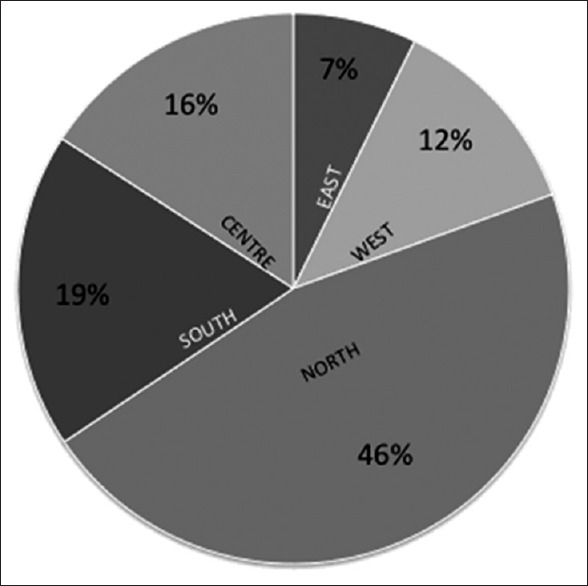
Region-wise distribution of IMS survey data
Figure 2.

Frequency distribution of survey data according to peri- and post-menopause status
Figure 3.
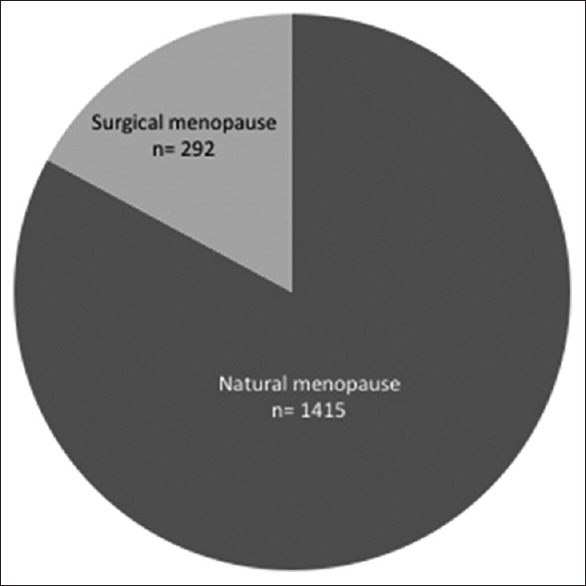
Frequency distribution of data according to menopause type, natural or surgical
The baseline characteristics and frequency distribution for 11 determinants which included occupation (O), community (C), education (Edu), socioeconomic status (SES), marital status (MS), food type (F), alcohol consumption (A), parity (P), abortion (Ab), smoking (S), and contraception (Con) were identified [Table 1]. Parity was put up as a categorical variable.
Table 1.
Baseline characteristics and frequency distribution of 11 determinants analyzed in the survey
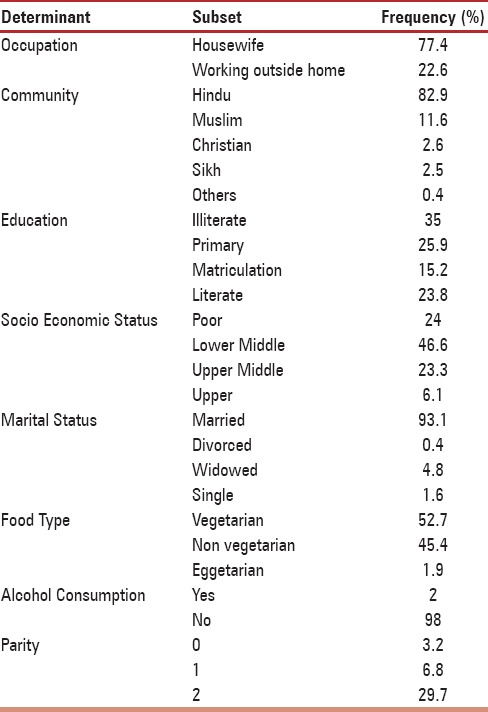
Data analysis
Mean menopausal and perimenopausal age
The perimenopausal age in Indian women is 44.69 ± 3.79 years. The mean menopausal age of the Indian women as interpreted from the survey is 45.59 ± 5.59 years. Menopausal age in different regions of India was as follows: East 45.1 ± 4.1 years, west 45.5 ± 3.8, north 45 ± 3.6, south 44.7 ± 3.3, and center 43.1 ± 4.8 years [Table 2]. A significant difference was observed between the menopausal age in the central Indian region and west (P = 0.02) and north (P = 0.01).
Table 2.
Mean natural menopause age in different regions of India

Natural menopause age of Indian women was determined to be 46.2 ± 4.9 years. Region-wise determination of natural menopause age was as follows: East 47.3 ± 3.9, west 46.2 ± 4.9, north 45.5 ± 4.9, south 46.1 ± 5.6, and center 47.8 ± 4.4 years [Table 2]. A significant difference was observed between north and east (P = 0.005), north and center (P < 0.001), west and center (P = 0.01), and south and center (P = 0.005).
Natural menopause age and lifestyle correlations
Multiple regression analysis showed a positive correlation between natural menopause age and MS (P < 0.001), marriage duration (P < 0.001), SES (P = 0.01), Edu (P = 0.03), and BMI (P = 0.03). A negative correlation was observed between natural menopause age and parity status (P = 0.04). No correlation was found for natural menopause age and occupation, community, food type, alcohol, smoking, abortion, or contraceptive use. Figure 4 shows the trend of BMI, waist circumference, and weight for various age groups in Indian women.
Figure 4.

A trend of body mass index, waist circumference, and weight for various age groups in Indian women
DISCUSSION
The current study identified 46.2 ± 4.9 years as the age of natural menopause in India. The Indian women begin their perimenopausal stage, identified by irregular periods, by the age of 44.69 ± 3.79 years. This result is in consistent with the recent Indian studies[7,8,9] Other studies conducted in India also show a similar profile in the age of menopausal women in India[10,11,12,13] The Indian menopause and perimenopausal age has been reported to be earlier as compared to the developed countries[14] We also observed the same. Correlating the earlier menopausal age with the risk of diseases, we do observe an increased risk of osteoporosis and heart attack in Indian postmenopausal women.[15]
Of the factors we studied, five factors had a positive correlation with the menopausal age while one factor had a negative correlation.
Marital status and menopausal age
A strong positive correlation (P < 0.001) was observed between MS, marriage duration, and menopausal age. Unmarried women were found to undergo early menopause as compared to married or widowed. In our study, we observed that while the mean menopausal age of unmarried women was 45 ± 6.3 years, it was 46.1 ± 4.9 for married women and 47.9 ± 4.8 years for widowed. Previous studies have also noted that married and widowed women report a later mean age at natural menopause compared to single and divorced women (P < 0.05).[16] A phenomenal influence of male in the household has been considered to be a possible reason for this variation in menopausal age.
Education, socioeconomic status, and menopausal age
Our study reported that more educated women have a significantly higher menopausal age (P = 0.028). The menopausal age in illiterate women was 46.1 ± 5.3 years while in primary educated was 45.7 ± 4.8, matriculate was 45.8 ± 4.8, and graduate and above was 47.2 ± 4.4 years. In addition, women belonging to upper SES have a higher menopausal age ranging from 46.1 ± 5.2 years in poor economic background to 48.1 ± 4.2 years in rich economic background [Figure 5]. In fact, a number of previous international studies have found a significant association of lower educational attainment and SES with an earlier menopause.[17,18,19,20,21] Social class has been consistently found to be positively associated with health and negatively associated with morbidity and mortality. This association could be explained by better nutritional status, reproductive choices, or stress variation between the upper and lower economic strata.[20] Moreover, there is an access to better health resources and medical care. In fact, one of the studies observed that women with better mental ability had a later age of menopause.[22] This could be due to the ability to perceive better health choices and decisions.
Figure 5.

Correlation between Age of menopause with Education, Socio Economic status and Parity
Body mass index and menopausal age
Lower BMI has found to be associated with earlier onset of menopause (P = 0.002) A number of international studies have also identified this association.[23,24] Several studies have indicated that BMI is the major determinant of endogenous estrogen levels. Women with higher BMI are supposed to have higher levels of estradiol (E1) and esterone (E2) in their body, leading to a delayed menopause.[25]
Parity and menopausal age
An inverse correlation was observed in our study between the number of children and the age of menopause (P = 0.038). Abortion was found to have no correlation with the menopausal age. Another Indian study conducted by the National Family Health Survey also reported a higher prevalence and earlier onset of menopause by multiple parity.[26] However, a number of studies have reported the prevalence of earlier menopause in nulliparous women. Although in our survey we also found the minimal menopausal age in nulliparous women, it was not statistically significant.
Smoking, alcohol, and contraception
We looked for the other confounding factors such as smoking, alcohol consumption, and use of contraceptives, but the data were very limited. In India, most women abstain from the use of tobacco or alcohol consumption or contraception. There is also a possibility that this information may not be rightly mentioned owing to shyness or social stigma.
Trend of body mass index, weight, and waist circumference with age
As the age of the woman increases, a trend of increasing waistline has been observed. This accumulation of fat could be due to hormonal changes around menopause. Similarly, an increase in weight and BMI was also observed as the age of Indian women increases [Figures 6–8].
Figure 6.

Trend for body mass index in Indian women in different regions at various age groups
Figure 8.
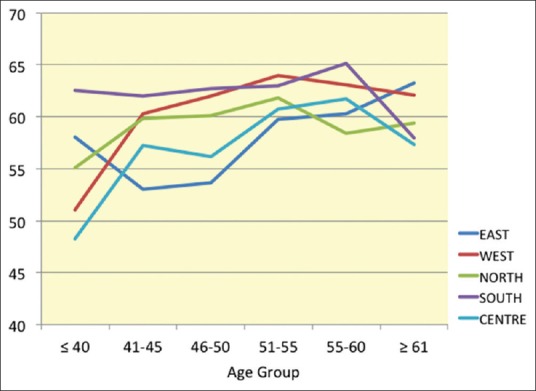
Trend for waist circumference for Indian women in different regions in different age groups
Figure 7.
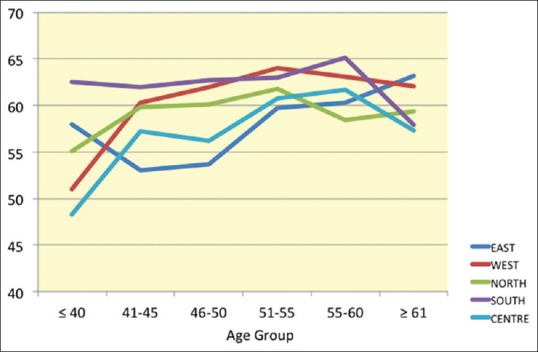
Trend of weight in Indian women in different regions at various age groups
Importance of this study conducted on the Pan India basis was not only to identify the current menopausal age, but the factors influencing it and largest number of factors were studied as determinants to the age of menopause. As far as our knowledge, this is the first Indian study to have the maximum enrollment of menopausal women.
LIMITATIONS
The age of menopause was determined by recall and there can be some variations on it, which attributed to the limitation of this study.
Financial support and sponsorship
Nil.
Conflicts of interest
There are no conflicts of interest.
REFERENCES
- 1.Cooper GS, Sandler DP. Age at natural menopause and mortality. Ann Epidemiol. 1998;8:229–35. doi: 10.1016/s1047-2797(97)00207-x. [DOI] [PubMed] [Google Scholar]
- 2.Kelsey JL, Gammon MD, John EM. Reproductive factors and breast cancer. Epidemiol Rev. 1993;15:36–47. doi: 10.1093/oxfordjournals.epirev.a036115. [DOI] [PubMed] [Google Scholar]
- 3.Colditz GA, Willett WC, Stampfer MJ, Rosner B, Speizer FE, Hennekens CH. Menopause and the risk of coronary heart disease in women. N Engl J Med. 1987;316:1105–10. doi: 10.1056/NEJM198704303161801. [DOI] [PubMed] [Google Scholar]
- 4.Khosla S, Riggs BL. Pathophysiology of age-related bone loss and osteoporosis. Endocrinol Metab Clin North Am. 2005;34:1015–30, xi. doi: 10.1016/j.ecl.2005.07.009. [DOI] [PubMed] [Google Scholar]
- 5.Ossewaarde ME, Bots ML, Verbeek AL, Peeters PH, van der Graaf Y, Grobbee DE, et al. Age at menopause, cause-specific mortality and total life expectancy. Epidemiology. 2005;16:556–62. doi: 10.1097/01.ede.0000165392.35273.d4. [DOI] [PubMed] [Google Scholar]
- 6.Sengupta A. The emergence of the menopause in India. Climacteric. 2003;6:92–5. [PubMed] [Google Scholar]
- 7.Singh M. Early age of natural menopause in India, a biological marker for early preventive health programs. Climacteric. 2012;15:581–6. doi: 10.3109/13697137.2011.643514. [DOI] [PubMed] [Google Scholar]
- 8.Kapur P, Sinha B, Pereira BM. Measuring climacteric symptoms and age at natural menopause in an Indian population using the Greene climacteric scale. Menopause. 2009;16:378–84. doi: 10.1097/gme.0b013e31818a2be9. [DOI] [PubMed] [Google Scholar]
- 9.Singh A, Pradhan SK. Menopausal symptoms of postmenopausal women in a rural community of Delhi, India: A cross-sectional study. J Midlife Health. 2014;5:62–7. doi: 10.4103/0976-7800.133989. [DOI] [PMC free article] [PubMed] [Google Scholar]
- 10.Sharma S, Tandon VR, Mahajan A. Menopausal symptoms in urban women. JK Sci. 2007;9:13–5. [Google Scholar]
- 11.Kakkar V, Kaur D, Chopra K, Kaur A, Kaur IP. Assessment of the variation in menopausal symptoms with age, education and working/non-working status in North-Indian sub population using menopause rating scale (MRS) Maturitas. 2007;57:306–14. doi: 10.1016/j.maturitas.2007.02.026. [DOI] [PubMed] [Google Scholar]
- 12.Borker SA, Venugopalan PP, Bhat SN. Study of menopausal symptoms, and perceptions about menopause among women at a rural community in Kerala. J Midlife Health. 2013;4:182–7. doi: 10.4103/0976-7800.118997. [DOI] [PMC free article] [PubMed] [Google Scholar]
- 13.Kriplani A, Banerjee K. An overview of age of onset of menopause in northern India. Maturitas. 2005;52:199–204. doi: 10.1016/j.maturitas.2005.02.001. [DOI] [PubMed] [Google Scholar]
- 14.McKinlay SM, Brambilla DJ, Posner JG. The normal menopause transition. Maturitas. 1992;14:103–15. doi: 10.1016/0378-5122(92)90003-m. [DOI] [PubMed] [Google Scholar]
- 15.Dosi R, Bhatt N, Shah P, Patell R. Cardiovascular disease and menopause. J Clin Diagn Res. 2014;8:62–4. doi: 10.7860/JCDR/2014/6457.4009. [DOI] [PMC free article] [PubMed] [Google Scholar]
- 16.Sievert LL, Waddle D, Canali K. Marital status and age at natural menopause: Considering pheromonal influence. Am J Hum Biol. 2001;13:479–85. doi: 10.1002/ajhb.1079. [DOI] [PubMed] [Google Scholar]
- 17.Gold EB. The timing of the age at which natural menopause occurs. Obstet Gynecol Clin North Am. 2011;38:425–40. doi: 10.1016/j.ogc.2011.05.002. [DOI] [PMC free article] [PubMed] [Google Scholar]
- 18.Luoto R, Kaprio J, Uutela A. Age at natural menopause and sociodemographic status in Finland. Am J Epidemiol. 1994;139:64–76. doi: 10.1093/oxfordjournals.aje.a116936. [DOI] [PubMed] [Google Scholar]
- 19.Gold EB, Bromberger J, Crawford S, Samuels S, Greendale GA, Harlow SD, et al. Factors associated with age at natural menopause in a multiethnic sample of midlife women. Am J Epidemiol. 2001;153:865–74. doi: 10.1093/aje/153.9.865. [DOI] [PubMed] [Google Scholar]
- 20.Stanford JL, Hartge P, Brinton LA, Hoover RN, Brookmeyer R. Factors influencing the age at natural menopause. J Chronic Dis. 1987;40:995–1002. doi: 10.1016/0021-9681(87)90113-5. [DOI] [PubMed] [Google Scholar]
- 21.Lawlor DA, Ebrahim S, Smith GD. The association of socio-economic position across the life course and age at menopause: The British Women's Heart and Health Study. BJOG. 2003;110:1078–87. [PubMed] [Google Scholar]
- 22.Shinberg DS. An event history analysis of age at last menstrual period: Correlates of natural and surgical menopause among midlife Wisconsin women. Soc Sci Med. 1998;46:1381–96. doi: 10.1016/s0277-9536(97)10085-5. [DOI] [PubMed] [Google Scholar]
- 23.Akahoshi M, Soda M, Nakashima E, Tominaga T, Ichimaru S, Seto S, et al. The effects of body mass index on age at menopause. Int J Obes Relat Metab Disord. 2002;26:961–8. doi: 10.1038/sj.ijo.0802039. [DOI] [PubMed] [Google Scholar]
- 24.Tao X, Jiang A, Yin L, Li Y, Tao F, Hu H. Body mass index and age at natural menopause: A meta-analysis. Menopause. 2015;22:469–74. doi: 10.1097/GME.0000000000000324. [DOI] [PubMed] [Google Scholar]
- 25.McTiernan A, Wu L, Chen C, Chlebowski R, Mossavar-Rahmani Y, Modugno F, et al. Relation of BMI and physical activity to sex hormones in postmenopausal women. Obesity (Silver Spring) 2006;14:1662–77. doi: 10.1038/oby.2006.191. [DOI] [PubMed] [Google Scholar]
- 26.Mozumdar A, Agrawal PK. Prevalence, trends, and determinants of menopause in India: NFHS 1992-93 to NFHS 2005-06. Am J Hum Biol. 2015;27:421–5. doi: 10.1002/ajhb.22648. [DOI] [PubMed] [Google Scholar]


